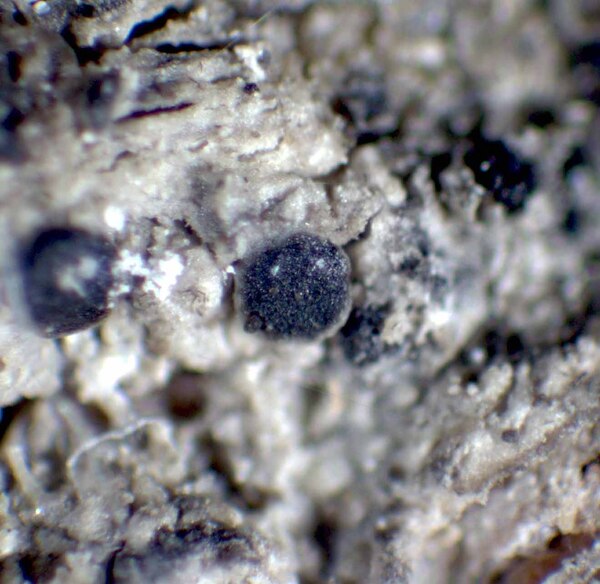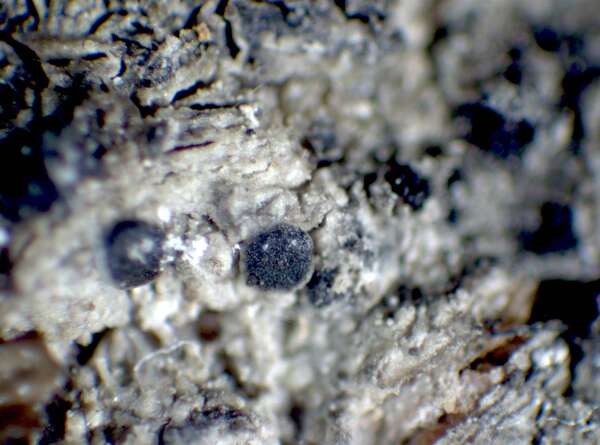Biatora mendax Anzi
Comm. Soc. Critt. Ital., 1, 3: 153, 1862.
Synonyms: Biatora propinquata (Nyl.) Arnold; Biatora subflavida (Nyl.) Arnold; Biatorina mendax (Anzi) Jatta; Catillaria mendax (Anzi) Lettau; Lecidea propinquata Nyl.; Lecidea subflavida Nyl.
Description: Thallus crustose, thinly episubstratic, greenish grey to pale grey (turning beige to pale brown in the herbarium), continuous to rimose-areolate, the areoles (which are rarely well-developed) flat, 0.25-0.8 mm wide, with partially raised margins. Apothecia biatorine, rounded or slightly irregular in outline, sessile with a slightly constricted basis, 0.4-0.7(-1) mm across, with a brown-black to black, rarely grey-brown, epruinose, flat to moderately convex disc, and an often slightly paler, thin, finally excluded proper margin; damaged apothecia often become tuberculate. Proper exciple well-developed, of branched, radiating hyphae with protruding, capitate terminal cells; epithecium sordid brown, K-, N-; hymenium colourless or brownish, 35-60 µm high; paraphyses simple or sparingly branched in upper part, 1-1.5(-2) µm thick at mid-level, the apical cells slightly swollen; hypothecium colourless, pale sordid brown, N-, 30-80 µm high, hardly distinct from the subhymenium. Asci 8-spored, clavate, with a K/I+ blue apical dome penetrated by a narrow, K/I– apical cushion surrounded by a narrow, deeply K/I+ blue zone, the wall K/I- but surrounded by an I+ red-brown, K/I+ blue outer layer, the ocular chamber relatively small, Biatora-type, 38-51 x 9-12.5 µm. Ascospores 1-celled (rarely 1-septate), hyaline, oblong-fusiform, (9-)12-17(-20) x (3-)3.5-4.5(-5.5) µm. Pycnidia rare, immersed, colourless or dark brown in the periostiolar region, more or less globose, c. 140 µm across. Conidia 5.5-8 x 0.7-1 µm. Photobiont chlorococcoid. Spot tests: thallus K-, C-, KC-, P+ orange-red. Chemistry: thallus with argopsin and traces of norargopsin.
Growth form: Crustose
Substrata: bark
Photobiont: green algae other than Trentepohlia
Reproductive strategy: mainly sexual
Commonnes-rarity: (info)
Alpine belt: absent
Subalpine belt: extremely rare
Montane belt: very rare
Dry submediterranean belt: absent
Humid submediterranean belt: absent
Padanian area: absent
pH of the substrata:
1 2 3 4 5
Solar irradiation:
1 2 3 4 5
Aridity:
1 2 3 4 5
Eutrophication:
1 2 3 4 5
Poleotolerance:
0 1 2 3
Altitudinal distribution:
1 2 3 4 5 6
Rarity
absent
extremely rare
very rare
rare
rather rare
rather common
common
very common
extremely common
Loading data...
Occurrence data
Predictive map
Growth form: Crustose
Substrata: bark
Photobiont: green algae other than Trentepohlia
Reproductive strategy: mainly sexual
Commonnes-rarity: (info)
Alpine belt: absent
Subalpine belt: extremely rare
Montane belt: very rare
Dry submediterranean belt: absent
Humid submediterranean belt: absent
Padanian area: absent
pH of the substrata:
| 1 | 2 | 3 | 4 | 5 |
Solar irradiation:
| 1 | 2 | 3 | 4 | 5 |
Aridity:
| 1 | 2 | 3 | 4 | 5 |
Eutrophication:
| 1 | 2 | 3 | 4 | 5 |
Poleotolerance:
| 0 | 1 | 2 | 3 |
Altitudinal distribution:
| 1 | 2 | 3 | 4 | 5 | 6 |
Rarity
absent
extremely rare
very rare
rare
rather rare
rather common
common
very common
extremely common
Loading data...
Occurrence data
Predictive map








